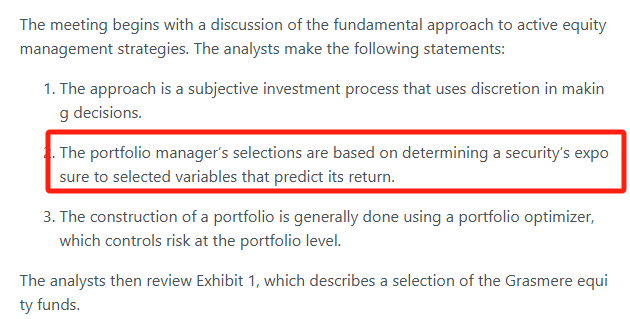NO.PZ201809170400000703
问题如下:
Aleksy Nowacki is a new portfolio manager
at Heydon Investments. The firm currently offers a single equity fund, which
uses a top-down investment strategy based on fundamentals. Vicky Knight, a
junior analyst at Heydon, assists with managing the fund. Nowacki has been
hired to start a second fund, the Heydon Quant Fund, which will use quantitative
active equity strategies. Nowacki and Knight meet to discuss distinct
characteristics of the quantitative approach to active management, and Knight suggests
three such characteristics:
Characteristic 1 The focus is on factors
across a potentially large group of stocks.
Characteristic 2 The decision-making
process is systematic and non-discretionary.
Characteristic 3 The approach places an
emphasis on forecasting the future prospects of underlying companies.
Nowacki states that quantitative investing
generally follows a structured and welldefned process. Knight asks Nowacki:
“What is the starting point for the
quantitative investment process?”
The new Heydon Quant Fund will use a
factor-based strategy. Nowacki assembles a large dataset with monthly
standardized scores and monthly returns for the strategy to back-test a new
investment strategy and calculates the information coefficient. FS(t)
is the factor score for the current month, and FS(t + 1) is the
score for the next month. SR(t) is the strategy’s holding period
return for the current month, and SR(t+1) is the strategy’s
holding period return for the next month.
As an additional step in back-testing of
the strategy, Nowacki computes historical price/book ratios (P/Bs) and
price/earnings ratios (P/Es) using calendar year-end (31 December) stock prices
and companies’ financial statement data for the same calendar year. He notes
that the financial statement data for a given calendar year are not typically
published until weeks after the end of that year.
Because the Heydon Quant Fund occasionally
performs pairs trading using statistical arbitrage, Nowacki creates three
examples of pairs trading candidates, presented in Exhibit 1. Nowacki asks
Knight to recommend a suitable pair trade.
Knight foresees a possible scenario in
which the investment universe for the Heydon Quant Fund is unchanged but a new
factor is added to its multifactor model. Knight asks Nowacki whether this
scenario could affect the fund’s investment-style classifcations using either
the returns-based or holdings-based approaches.
Which characteristic suggested by Knight to describe the quantitative approachto active management is incorrect?
选项:
A.Characteristic
1
Characteristic
2
Characteristic
3
解释:
C is correct. Quantitative analysis uses a company’s history to arrive at investment decisions. The quantitative decision-making process is systematic and non-discretionary (whereas the fundamental decision-making process is more discretionary), and the focus of the quantitative approach is on factors across a potentially large group of stocks (whereas fundamental strategies focus on a relatively small group of stocks). In contrast, fundamental analysis (not quantitative analysis) emphasizes forecasting future prospects, including the future earnings and cash flows of a company.
Characteristic 3 The approach places an emphasis on forecasting the future prospects of underlying companies.是这么说的;
NO.PZ202207040100000306是这么说的

请教两者的区别




